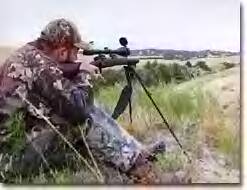A WIDE WORLD OF HUNTING R
EPRINT FROM CABELAS.COM
Riflescope Buyer's Guide and Glossary
|
|
Telescopic sights have been around since before the
Civil War, but only in the years after World War II did manufacturers continue
to make improvements to scopes offering hunters reliable equipment that would
soon become a standard on modern hunting rifles.
What does a scope do for you?
One of the main uses of a riflescope is that it magnifies your target, giving
you a clearer sight picture than with the naked eye. This not only allows you to
shoot more accurately at a greater distance, but it also increases safety since
you can better see the target and what lies behind it.
A scope can also give you more hunting time early and late in the day. These are
two prime times for big game to be moving to and from their bedding areas, but
with iron sights, often there is not enough ambient light available to make an
ethical shot. Riflescopes accentuate available light and make it possible for
you to accurately shoot in low light conditions.
A riflescope also allows a higher level of precision than traditional iron
sights. At 100 yards, an iron ramp sight will cover up to 6 inches of the
target. Precise bullet placement is limited by the large amount of the target
that is covered. However, riflescopes use various reticles (commonly called
crosshairs) that in fine target models only cover an 1/8 of an inch at 100
yards. This is the ultimate in precision, allowing you to place a shot exactly
where you want every time - even in the same hole as the previous one.
Finally, a riflescope allows you to take full advantage of the modern cartridges
and rifles available today. New calibers and rifles shoot flatter, farther, and
have more energy than turn of the century models. With a correctly mounted and
sighted in riflescope and a little practice, hunters can now make precise shots
on game at longer distances then before though possible.
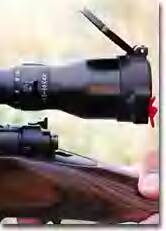 |
The Numbers and What They Mean
When you first look at scopes, you will be in awe of the number and models
available. Manufacturers use a series of numbers for comparison, and without
knowing what they mean, it is hard to make an accurate comparison.
Power: Commonly a riflescope will be expressed in a series of numbers
such as 3.5-10x50 or 4x32. The first number's, in this case 3.5-10 or 4, is the
power. Power expresses the magnification as a factor compared to the naked eye.
So in a fixed power scope, such as the 4x32, the object in view is
magnified 4 times. An object would appear to be 4 times closer than it would
with the naked eye. Therefore, a higher number has a greater magnification. Most
scopes sold today are variable power, such as the 3.5-10 mentioned above.
This allows greater versatility, since in this case, the shooter can vary the
magnification from 3.5 to up to 10, with infinite values in-between.
The power that you select depends on the kind of hunting you will be doing. If
you are planning on hunting in close cover, you will want either a low power
fixed scope such as a 4x or a variable that goes down to 3.5x or even lower.
This will give you a wider Field of View and allow you to acquire a target
quickly in close cover. On the other hand, if long range varmint or target
shooting is in your plans, you might want a scope that goes as high as 16x or
even 20x. This will allow you to see small prairie dogs or the 10-ring clearly
at 400 yards. For all around hunting, a range of 3.5-10 or 4-12 will allow some
serious range variation, while still dialing down for close shots.
Objective: The second number in a scope, such as the 50 in a 3.5-10x50,
is the diameter of the objective lens in millimeters. A 50 designation means
that the outer lens is 50 mm in diameter. A larger number indicates a larger
lens. Large lenses are more bulky, but they also offer a bit larger field of
view and let in more light, which makes your image clearer - especially in low
light conditions.
The low light performance is due to the maximum exit pupil offered by a larger
objective. Exit pupil is the size of the beam of light that leaves the
scope. The exit pupil can easily be calculated (in mm) by dividing the diameter
of the objective lens by the power. Therefore, a 4x32 scope has an exit pupil of
8mm. On a bright day, the human pupil will vary from 2mm at noon to 4mm later in
the day. When your eyes become adapted to dark conditions, such as pre-dawn and
after sunset, when big game are moving, the pupil will vary from 5mm to a
maximum of 9mm.
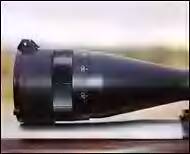 |
On a bright day, having a scope with a larger exit pupil
will have little effect. The only difference you may notice is that you will be
able to move the scope and still maintain the image. In low light, the exit
pupil is the biggest factor in getting as much light as possible to your eye.
Adjustable Objective: On some scopes, the objective lenses are
adjustable. This allows you to focus at distances over 100 yards and adjust for
a condition called Parallax. The scopes with adjustable objective lenses
have markings that allow you to adjust the focus for specific ranges. Parallax
occurs when viewing distant targets, and the reticle appears to shift or move.
This occurs when the image in the scope is in one focal plane, and the reticle
is in another. Most scopes without adjustable objectives are factory set to
compensate for parallax and focus at an optimum distance of 100 or 150 yards.
Parallax is usually only an issue at magnification over 10 power. When looking
at a scope that will be used for distant targets in higher power, an adjustable
objective is a good choice.
Reticle: The reticle is the aiming point within the scope - commonly
called "crosshairs" due the standard arrangement being two thin wires
that cross. They are also available in different combinations including, pointed
posts, dots, multiple dots and bars. One of the more common reticles is a duplex
or multiplex design where the main crosshairs are thicker for easier viewing
(especially in low light), and as they near the center where they cross, the
crosshairs become very fine, allowing for precise target placement. You will
want to choose a reticle that best suits your style of shooting. For example, a
heavy duplex reticule would be best for a shotgun scope used in heavy brush,
where fine reticles would be difficult to see.
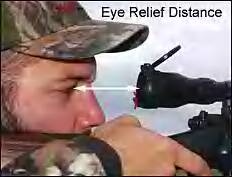 |
Eye Relief: Eye relief is the comfortable
distance that a scope can be held from the eye and still allow the shooter to
see the entire image. It is literally the distance of your shooting eye to the
eyepiece. It will usually be stated as a range, since in a variable power scope
the eye relief will vary with the power. Lateral adjustment can be made while
mounting the scope to give the individual shooter the optimum eye relief. On a
rifle, the more generous the eye relief the better. This will allow you to
acquire the target more quickly, which is a must for running shots. Three to
four inches is a good number that will fit most hunters. On large, magnum
rifles, you want a maximum of relief, so when the rifle recoils, the scope
doesn't come back and possibly injure the shooter.
When mounting a scope on a handgun, you will need a special pistol scope that
has an eye relief of 12 to 24 inches. This will allow you to hold your handgun
in a comfortable shooting stance and still see the full image through the scope.
FOV @ 100 yards: FOV stands for Field of View. What this means is how
wide of an area (in ft.) that you can view at 100 yards. A higher number
indicates a wider area, while a smaller number indicates a narrower area. The
focal length of the objective lenses and the eyepiece design have the most
impact on the actual FOV. The power of the scope has an inverse relationship
with FOV. As the magnification increases, a smaller FOV results. If you are
looking for a scope for quick target acquisition in close cover, your will need
a wider field of view and therefore, a smaller power.
Minute of Angle: Minute of Angle (MOA) is a term to designate variances
on a target at 100 yards distant. Most commonly, it is used to describe the
adjustment on a scope. If a scope's adjustments are listed at ¼" MOA, then
for every click of the adjustment knob, the bullet's point of impact will move
¼" at 100 yards.
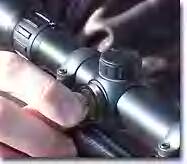 |
Windage: Windage is the term for horizontal
adjustment of your scope.
Elevation: Elevation is the adjustment of the scope in the vertical
direction.
Tube Diameter: The majority of the scopes on the market come with the
main tube having a one-inch diameter. Several European models and now a few
others also come with a 30mm tube diameter. Contrary to popular belief, the
larger tube does not allow more light to reach your eye. The exit pupil
mentioned above controls this. However, a larger tube diameter does give added
strength and rigidity due to the greater cross sectional area and larger rings
and mounts. A larger tube diameter also allows for an increased range of
adjustment for windage and elevation.
Optical Coatings: The largest limitation of light transmission in
riflescopes is reflected light. Any time that light strikes a glass surface, up
to 5% of the light can be reflected back. However, if a thin chemical film
(commonly Magnesium Fluoride) is used to coat the surface of the glass, much of
the reflection can be eliminated. The coating reduces light loss and glare,
increasing light transmission and resulting in brighter, clearer images. By
coating a surface with multiple films, the effect of the coating is increased,
at times limiting the amount of reflected light to 0.25% to 0.5% per glass
surface.
Airgun Scopes: The unique recoil pattern of spring piston airguns
requires the purchase of a special airgun scope. Unlike centerfire and rimfire
rifles that recoil only in one direction, airguns recoil both rearward and
forward. This double recoil action can damage scopes that are not designed to
handle it.
Length and Weight: When carrying your rifle for a long time, every extra
ounce can weigh you down. While larger objectives and variable power have their
benefits, the extra ounces quickly add up for all these features. If you are
looking to minimize the weight of a rifle that you will be carrying a lot,
consider a compact, fixed power scope with a medium sized objective. It will
provide a large exit pupil with a bright image and weigh a lot less than a
variable power scope.
By: Mark Mazour
1998-2007 WIDEWORLDOFHUNTING.COM ™, WWH™ , WWOH™ ,
WIDE WORLD OF HUNTING AND THE GREAT OUTDOORS ™, WIDE WORLD OF HUNTING™
DeerDope™ ALL RIGHTS RESERVED
Nikon Bushnell Leopold Zeiss Tasco Buckridge Leica Kahles Weaver Swarovski
